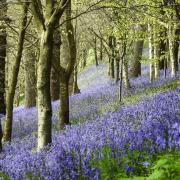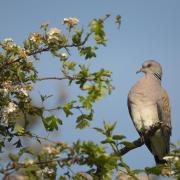A cold winter breeze rushes over the shingle landscape carrying with it the whistling calls of wigeon, a species of duck that has come to spend the winter at RSPB Dungeness. As soon as you arrive at the reserve, your senses are filled with the sounds of nature and the wildness of this unique landscape, which stretches out into the distant view across the peninsula. Over 800 hectares here are managed for wildlife, including rare plants, lichens and insects. However, in winter it's the wildfowl and waders that are the stars of the show.
As soon as you enter the visitor centre you’re welcomed by the antics of dabbling ducks like gadwall and teal, which are visible outside. The male teal has a vibrant green eye patch across its chestnut brown head. Take a seat by the large windows and looking further out across the lake, known as Burrowes Pit, you can see cormorants that congregate on the islands, holding their wings out to dry.

The way-marked trails guide you around wild wetland, shingle and reedbed habitat with hides and family-friendly viewing platforms along the way. The wildlife on the lakes is fun to watch at this time of year as ducks that spend the winter here, including wigeon, pintails, shovelers and pochards, are busy feeding.
'There’s such a variety of species you can see, it just depends on the winter’s weather,' says RSPB Dungeness Warden Craig Edwards, who’s worked here for over 12 years. 'During cold seasons, we’ve seen goosanders, mergansers and even smew. Visitors could also spot cattle egrets and glossy ibis, which are more recent additions to the reserve’s sightings list.'

Another highlight of visiting RSPB Dungeness is the chance to spot reedbed specialist species. Go into Denge Marsh Hide or pause at the viewpoint nearby for a chance to see the majestic Marsh Harrier glide over the reeds. If you see a brown patterned bird creep out of the base of the plants this is the secretive bittern, while smaller birds called bearded tits may pop up and perch on the tops of the reeds. Can you hear their ‘ping’ sounding calls?
'It’s really special when we’re working on the reserve and the bearded tits appear,' Craig says. 'They fly in really close, and it’s such a great moment to see a species thriving that you’re working so hard to protect.'
Winter is also the best time of year to see wading birds, including large flocks of lapwing and golden plover. Look on the lake’s islands where these species like to roost. There are 57 islands in total for wildlife here, created by the onsite team.

'The extremes of weather that come with climate change has led us to increasing islands and their height to ensure there is space for birds to breed and roost,' explains Craig.
And that’s not all, there are future plans to provide more island homes for nature over the next few years.
As the sun sets on a cold winter’s day a dramatic murmuration of starlings swoops overhead dancing above the reeds. It’s not difficult to see why RSPB Dungeness is an oasis for nature and people, a much-loved space on this unique peninsula. With so much to see, there’s many reasons to keep coming back.

'My favourite part of the reserve changes all the time,' Craig says. 'Sometimes I'm at the viewpoint, the sun is setting, a marsh harrier flies past and I think nothing can beat it. Then the next day something does.'
The team always love to hear what wildlife is spotted on the reserve, so do pop into the visitor centre and share your sightings after your walk. With plenty of wildlife products available in the shop, you can pick up bird food, nest boxes or binoculars to increase your chances of seeing wild sights at home too.
rspb.org.uk/Dungeness




























